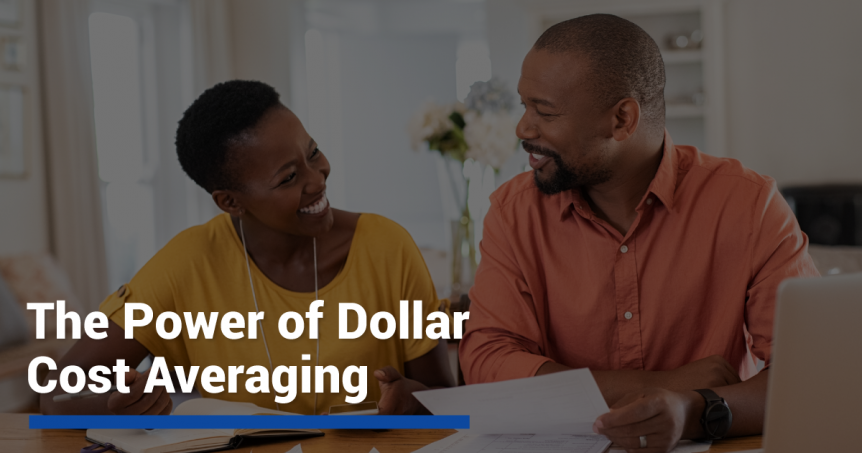A variance of dollar cost averaging is a critical component of the Snider Investment Method. So, let’s define dollar cost averaging, explore some of its benefits, and illustrate how this strategy helps conquer some harmful investment practices.
You may be familiar with the term dollar cost averaging. With this strategy, you buy a fixed dollar amount of a particular investment on a regular schedule, over a period of time, regardless of the share price. The result is that more shares are purchased at low prices and fewer shares are bought at higher prices.
You have likely used or are using dollar cost averaging without even knowing it. If you have ever had a company retirement plan like a 401(k), you likely dollar cost averaged your investments every month or year.
401(k) investors make regular monthly or annual investments into the mutual funds in their portfolio. Since the monthly contribution amount is set, you will buy more shares when prices are down and fewer when fund prices increase.
Benefits of Dollar Cost Averaging
The biggest benefits of dollar cost averaging include:
- Reducing the risk of making one large lump-sum investment in a security at the WRONG time – which is when it’s selling at a high price
- Potentially lowering your overall, average cost of an investment
The Snider Investment Method incorporates a slightly modified version of dollar cost averaging to allow investors to address, among other things, two important philosophical principles:
- Emotions are an investor’s worst enemy
- Market timing is a lie
First, let’s talk about emotional investing. When we see stocks go up and down, it’s almost impossible to truly make a sound and logical decision of how to react unless you have a rock-solid, time-tested, rules-based system to follow. That’s what sophisticated and professional investors have that the average guy in the market does not.
What Emotional Investing Looks Like in the Real-World
Example: So then, let’s say you heard that ‘Orange’ – a technology and consumer electronic developer – is the most owned stock on Wall Street and its value is still climbing. What are you likely to do? Jump on the band-wagon.
So you dump $20,000, as a lump-sum of money, into ‘Orange’ stock.
You walk away thinking you’ve just made a great decision; because you bought a Wall Street winner.
Analysis: You have to think about the risk of paying too much for a stock. So then, when you dumped $20,000 into Orange, especially since it’s already such a popular stock, possibly, you bought Orange at the wrong time.
In other words, if you buy when everybody owns it, the price has been rising before you got to it, so you could have paid a much higher price per share than you should have.
And what happens if, or when, bad press comes (like the bad press that hot, nation-wide, Mexican grill restaurant chain has been getting all year), and the stock’s price falls. You jump ship, along with everybody else, losing money in the process.
This is the vicious cycle of emotional investing that most people in the stock market are trapped in.
Dr. Daniel Kahneman, one of the founding fathers of behavioral economics and the only psychologist to ever win the Nobel Prize for Economics Research conducted research and found that, “when faced with uncertainty, investors tend to make decisions based on their emotions and subjective experiences, not on logic or objective reality.”
Investing is inherently risky, so learning a proven and disciplined approach is critical to conquering emotional investing.
Your Alternative to Market Timing
We all wish we could buy a stock today, that’s selling for $5 a share, if we had a crystal ball and knew that it’ll be selling at $105 just 8 years from today. But short of having a crystal ball, you shouldn’t believe any so-called ‘professional’ who suggests that they perfected a charting system that allows them to effectively time the market.
The truth is none of us knows whether the market’s going up or down tomorrow, let alone a month or year from now. However, the longer your time frame, the more likely you are to see investment gains. So the better approach to buying a stock is Dollar Cost Averaging. Instead of dropping $20,000 in one lump sum, try buying $1,000 a month over the next 20 months. That way, you buy fewer ‘Orange’ shares when prices are high and you buy more shares when prices are low.
Who Should Consider Dollar Cost Averaging
For any long-term investor, this is a good stock purchasing strategy. In other words, you must be prepared to look at your investment over the course of years, rather than days or weeks.
You must also be comfortable with buying and holding more of a stock that may decline in price and be confident in the long-term profit potential of your investment. These are tough decisions to make and it’s even tougher to invest well without getting a complete investment education that empowers you to build your financial house on solid ground.
This is why you should learn more about how dollar cost averaging is used as a part of the Snider Investment Method for the goal of helping our clients and students manage their portfolios and achieve a dream retirement.







